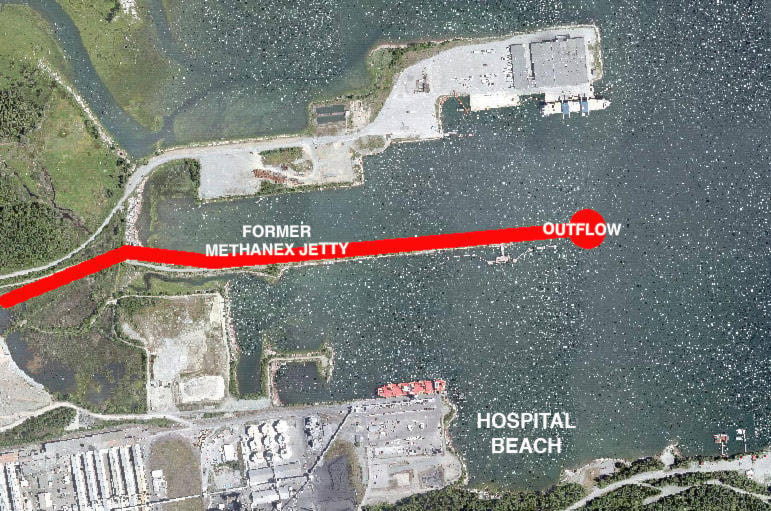An application to pump up to 2,490 cubic metres of wastewater a day into the Kitimat Arm is currently being considered by Transport Canada.
The application, submitted to the Transport Canada in September, was advertised in both the Northern Sentinel and the Terrace Standard in October and early November.
The advert read: Fluor Canada Ltd, on behalf of JGC Fluor BC LNG Joint Venture, hereby gives notice that an application entitled “LNG Canada Project – Marine Outfall – Municipal Effluent Discharge from Cedar Valley Lodge” has been made to the Minister of Transport.
JFJV spokesperson Rebecca Boys said the company is applying to place a three-port outfall diffuser on the seafloor in the port, 30 metres below the water surface about 240 metres off the southern end of the former Methanex jetty causeway.
The project also includes running an eight-inch diameter high-density polyethylene (HDPE) pipeline on the seafloor out to the outfall diffuser, as well as placing rip-rap scour protection at the shallow sections of the pipeline.
The pipeline and diffuser will be used to dispose of treated wastewater pumped from a waste treatment facility built to treat wastewater from LNG Canada’s main worker accommodation camp, Cedar Valley Lodge.
The wastewater, which will contain both treated sewage and grey water (water from kitchens, bathrooms and showers), will be treated using a treatment plant which is being purpose-built in Vancouver.
“The Cedar Valley Lodge wastewater treatment plant will use a process similar to other treatment facilities —including those used for workforce accommodations—that are governed by the provincial Municipal Wastewater Regulation,” said Boys. “It has been designed to meet more stringent effluent quality criteria, set by federal Wastewater Systems Effluent Regulations under the Fisheries Act.”
Technically, that means using Suspended Air Flotation with the addition of chemical coagulant and polymer; Mixed Bed Biofilm Reactor (biological); and ultraviolet (UV) disinfection.
“The way the effluent is being treated on the project is standard and likely the same process the District of Kitimat follows,” said Boys.
“The effluent will not adversely affect water quality and water uses. There will be no visible plume at the surface, and no odours from the treated effluent discharge.”
Information relating to the application on Transport Canada’s website refers to an expected construction start date of December 10, 2019, and a completion date of December 20.
The information also refers to Indigenous consultations – which is, in this case, would be with the Haisla Nation Council (HNC).
Chief councillor Crystal Smith released a brief statement regarding consultation over the application.
“We are still working through this process with the Ministry of Environment and JFJV,” said Smith.
It is unclear when the application will be approved – no environmental assessments have been conducted and the application status reads “In Progress.”
